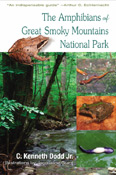The Amphibians of Great Smoky Mountains National Park

- Author(s): Dodd, Kenneth C.
- Series:
- Imprint: Univ Tennessee Press
- Publication Date: 2004-06-04
- Status: Active
- Available in Paper: Price $24.95 | Buy Now
“Most guides to animals in parks are intended primarily as identification aids and include relatively little on the biology of the species. Dodd’s book is much more, with detailed information on all aspects of the natural history of these species. Biologists, students, and visitors to Great Smoky Mountains National Park will find this an indispensable guide.”—Arthur C. Echternacht, Professor of Ecology and Evolutionary Biology-University of Tennessee
The Amphibians of Great Smoky Mountains National Park is the first book devoted entirely to the natural history of the forty-four species of amphibians known to occur presently or historically in the Great Smoky Mountains of North Carolina and Tennessee, in the most-visited national park in the United States.
Features• The only comprehensive book on the natural history of the amphibians of Great Smoky Mountains National Park• Beautiful original illustrations of salamander and frog larvae taken from specimens within the park• History of research and management effects on amphibians within the park• Extensive new information on the natural history of amphibians, based on four years of intensive field research• Simplified identification table guide to amphibian larvae• Summary of information on distribution (with range maps) and biogeography• Comprehensive bibliography of the literature on amphibians within the park• Summary of new data on the conservation of southern Appalachian amphibians, particularly with regard to land use, the effects of UV light, and disease
C. Kenneth Dodd is a research zoologist with the U.S. Geological Survey at the Florida Integrated Science Center and is president of The Herpetologists’ League. He is the author of North American Box Turtles: A Natural History and numerous articles in Journal of Herpetology, Biological Conservation, Herpetologica, and other publications. He lives in Gainesville, Florida.
